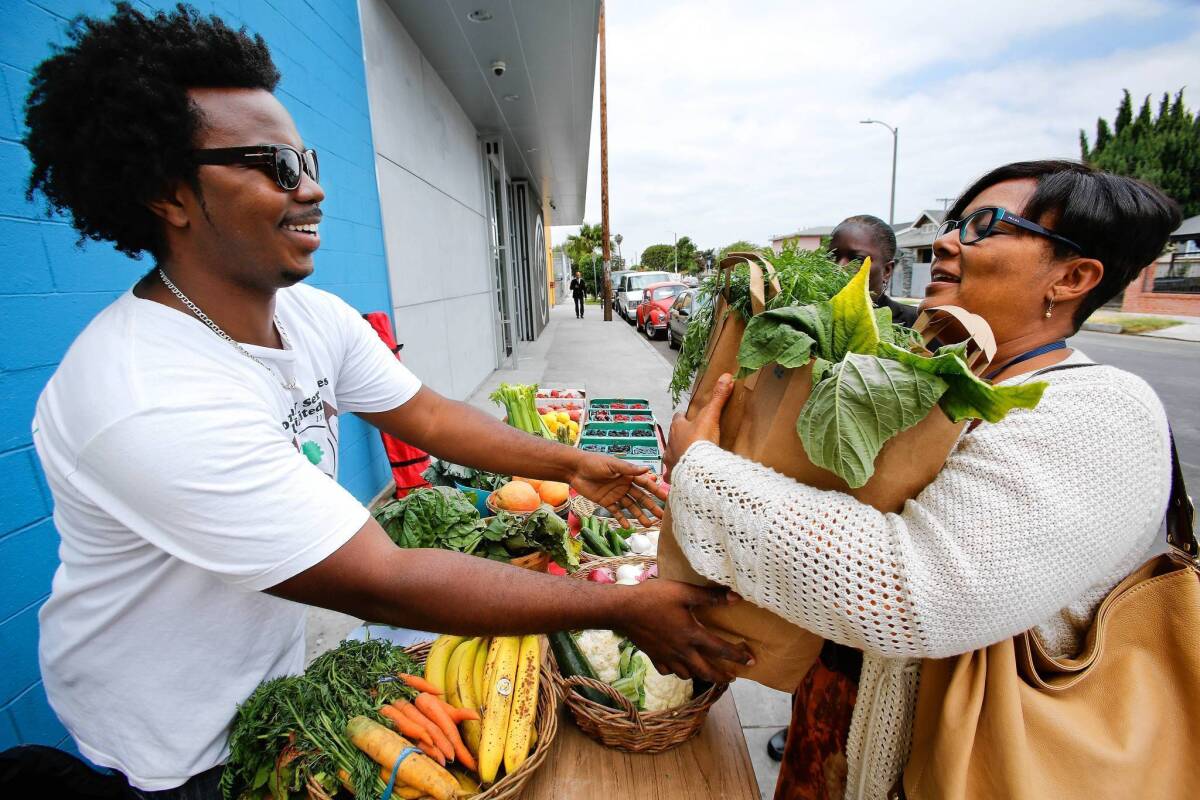South L.A. health center adds fresh produce to its mix of services

- Share via
Half of physician Mimi Choi’s pediatric patients are overweight or obese. She instructs them to eat more fruits and vegetables.
Now she can go one step further — refer them to a discounted produce stand steps away from the South Los Angeles health center where she works.
Choi said she can talk about better nutrition until she is “blue in the face,” but her patients will eat more fresh food only if it’s available and affordable.
“One of the biggest issues is access,” she said. “It’s really exciting that it’s right outside of the clinic.”
St. John’s Well Child and Family Center has partnered with a local nonprofit to run weekly produce stands at two of its sites for patients, families and clinic staff. The clinic is doing more than just making the food available — medical providers have begun writing “prescriptions” for patients to purchase the organic produce, Chief Executive Jim Mangia said. The prescriptions reinforce the fact that diet can be as important as medication, he said.
Doctors around the nation are undertaking similar efforts to promote healthier diets. At Boston Medical Center, for example, doctors write healthy food prescriptions that patients can get filled for free at a pantry within the hospital.
St. John’s nutritionist Ivy Marx said the stands are especially important in South Los Angeles, where rates of chronic disease are high and fresh food is hard to find. About 70% of the St. John’s adult patients are obese or overweight, and only 11% of adults eat the daily recommended fruits and vegetables, according to clinic data.
The partnership with Community Services Unlimited, which sells produce from local farmers and mini urban farms, began two years ago. On Monday, the first day of the new season, customers could choose celery, strawberries, garlic, mangoes, kale, lemons and other produce.
They could also subscribe to a weekly produce bag that comes along with a newsletter featuring cooking and nutritional information. The bags can be tailored for diabetics or patients with other needs.
Community Services Unlimited wants to make fruits and vegetables as accessible as fast food, said Dyane Pascall, the group’s finance director. “People eat what’s in their environment,” he said. “If you change their environment, they will change their diets.”
As people walked by Monday, Pascall called out, “Fresh fruits and vegetables!” He also handed out maps of South Los Angeles showing places to find fresh food, including farmer’s markets, grocery stores and community gardens.
Sonia Herrera, 50, brought her niece, Rosa Navas, to the clinic for a physical. The doctor told Herrera that the 3-year-old weighed more than she should. “She told us we have to give her more fruits, vegetables and water,” Herrera said. On her way out, Herrera stopped and bought her niece bananas and a basket of strawberries.
Luis Cantero, 50, bought cherries, blackberries and raspberries using a food-stamp debit card. Cantero said the fruit looked much better than in the grocery store.
“It’s good for me,” he said. “It’s natural.”
More to Read
Sign up for Essential California
The most important California stories and recommendations in your inbox every morning.
You may occasionally receive promotional content from the Los Angeles Times.













